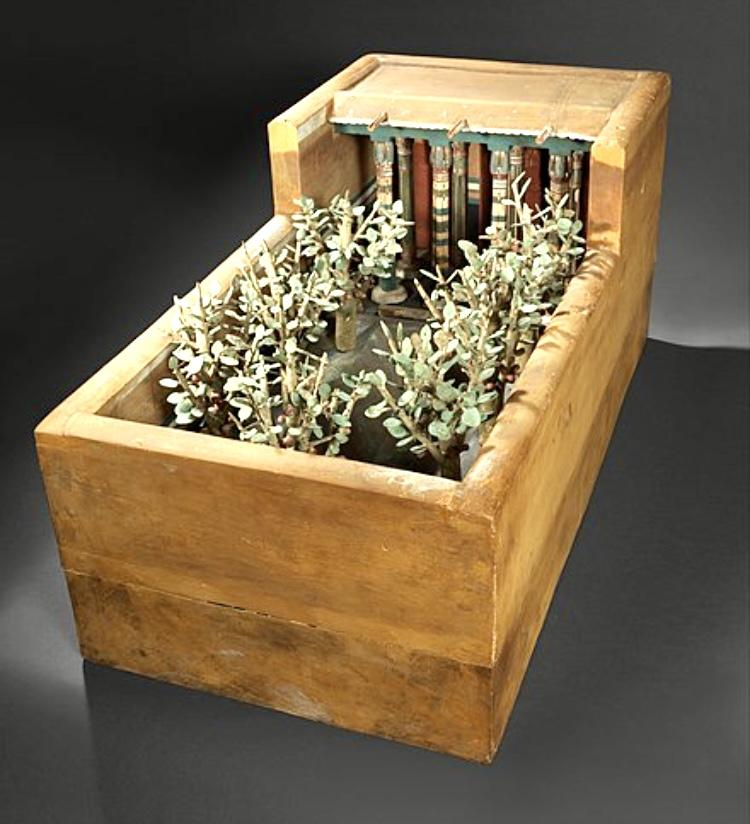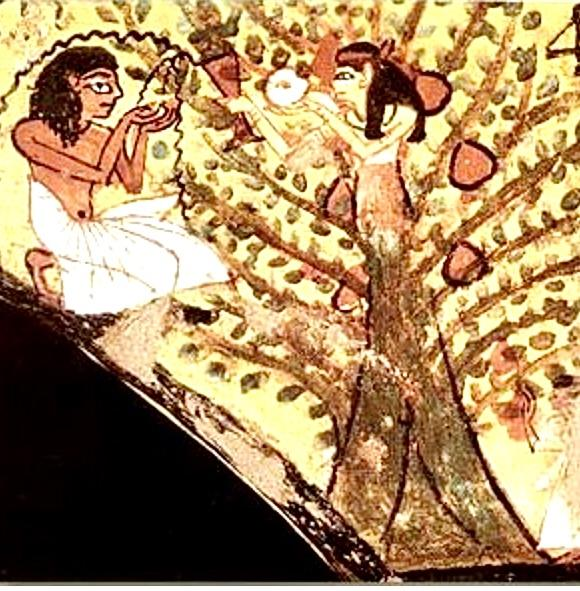Nut, the Egyptian sky goddess is often pictured arched over the Earth, her naked blue body covered with stars. But she also protected the deceased in their journey to the underworld. In that task she was connected with the sycamore, one of the many sacred trees in ancient Egypt. We shall first try to understand why trees have sparked the mythical imagination in so many cultures around the world before analyzing the fascinating connection between Nut and the sycamore.
Trees are Life, Trees, our Life
Trees have been on Earth long before Mankind. We now know how they provide oxygen and how this changed the atmosphere on earth making it fit for other living beings. When humans appeared, trees played an essential role in the survival and evolution of the species. Recent studies confirm that forest trees were their first natural habitat. Trees are life-giving in many other ways: food and timber. Fire was a major breakthrough in the history of mankind, protecting humans from wild beasts, changing the way they ate their food, allowing the invention of all kinds of techniques. But without wood, no fire. The greedy flames feed on wood. No wonder the tree that offered so many gifts and was the tallest and biggest plant on our planet was worshiped and thought to be sacred in many cultures.

Tree worship could take on several aspects. Some species were associated with one god in particular. In the Greek pantheon, the majestic oak was the emblema of Zeus, the King of gods, the olive-tree was Athena’s and the laurel, Apollo’s. In ancient times, all through Europe, some groves in the forest were sacred and people hung offerings on the branches of its trees. Roman and Greek were admired for their beautiful marble temples and so Roman historian Tacitus describes with amazement the religious rites of the German tribes: «They also judge, from the greatness of the divine, that a god should not be enclosed within walls, nor given the likeness of a human face, rather they consecrate woods and groves». A cluster of trees in the middle of the forest was all that was necessary to connect with the divine. Some forests were enchanted for the Celts. Broceliand was a mysterious and magical place where the wanderer could come across fairies, ogres, Merlin the Enchantor or Lancelot, one of the knights of the Round Table on one of his quests. In some villages in medieval France a tree grew in the nearby forest which was believed to be the meeting-point where witches performed their dark rituals under the eerie light of the moon. Some of these trees still exist today. The oak of Saint-Avold is 850 years old.

Romantic poets of the nineteenth century often compared forests to natural cathedrals where you could feel the presence of god and on the other way round the wooden structure of cathedrals was called the forest.
The Tree of Life which figures in so many religions has a special place amongst these sacred trees. The branches of a tree seem to reach to the skies and the roots sink deep into the earth. In some cultures, the world is conceived as a gigantic tree. Perun is the Slavic god of thunder and lightning and one of our Herojis. According to Slavic mythology, the world is a majestic three-tiered oak-tree. The top was the domain of the celestial beings, the branches and trunk represented the physical world (plants, animals and humans), the roots were the underworld, the realm of the dead. The picture shows the tree of Life according to Norse mythology:

Trees of life are very often associated with immortality and knowledge. In the Bible, Adam and Eve were forbidden to partake of the fruit of the Tree of Life, also called the Tree of the Knowledge of Good and Evil. They disobeyed and were expelled from the garden of Eden. Egyptians also knew of a Tree of Life that could bestow eternal life and wisdom. It was either an Ished tree, an acacia or a sycamore. It grew in the courtyard of the temple of Ra, the Sun god in Heliopolis. In the beginning, floods covered the earth until a mound emerged. On this island sprung the tree of Life. Its branches reached up to heaven to support the sky and the stars and its roots sunk deep into the water abyss of the underworld. Its trunk was an axis mundi, the pillar around which the world was structured. Thus the Tree was linked to the creation of the world and the birth of Ra and the other major gods of Heliopolis. It became a symbol of knowledge because it kept the memory of the creation of the world and of the divine plan. It was a map of destiny.
We shall now focus on the sacred sycamore and its connection with Nut.
A tree grows in the desert
The sycamore is a gift of nature. Egypt being mostly covered with deserts had few forests. Trees were a rare commodity. Pharaohs made it their duty to plant trees using the waters of the Nile. But one tree stood apart. The sycamore or ficus sycamorus , a fig species, was a sturdy, majestic, resilient tree. It could grow far from the Nile at the edge of the desert.

For the traveler, the sight of a sycamore meant shade, fruit and water nearby. The sycamore provided fruit and timber and it was also used for medicinal purposes. We can read in an ancient manual: « for correcting the urine of the diseased pubic area, on the first occurrence of suffering: honey, one, terebinth resin, one seed of grass, one Cyperus grass, one fruit of sycamore».
In a country dominated by the desert, gardens were precious havens. And when you live near the desert, you look for shade and cool water above all. In ancient Egypt, the two basic elements of a garden were a pond and rows of sycamores. In their biographies, rich Egyptians boast of their achievements. «I have built a house, set up its doors. I have dug a pool surrounded by sycamore trees» says one. «I have also dug a pool and planted forty sycamore trees» says another. Of course gardens were more elaborate. The pool was filled with fish and surrounded by reeds and marshes for waterfowl. It was bordered by symmetrical rows of tree : sycamores, palm trees, acacias. Colorful birds filled the air with their singing. A fresco dating from the eighteenth dynasty gives us an idea of these exquisite pleasure grounds.

The sycamore was also known as the tryst-tree. Lovers would meet under its lofty shade.
Death and rebirth: accordingly the bounteous sycamore was regarded as a sacred tree that grew in sacred sites. In Memphis, we can see the ruins of a little square temple dedicated to goddess Hathor. On the south corners grew two sycamore trees. Initially the temple was surrounded by water symbolizing the primordial sacred mound that emerged from the flood.

We have now to understand why sycamores or gardens with sycamores were planted near tombs. Gardens were even painted on the walls of tombs and small model gardens were placed in the sarcophagi.

We could argue that the dead who had enjoyed these gardens during their life wanted to enjoy them in the afterlife. This is certainly true but there are deeper meanings. The Book of Dead is a collection of texts consisting mainly of magic spells intended to help the dead person in his journey to the underworld where he would have to face Osiris and the weighing of the heart judgment.

The texts are illustrated with pictures. Texts and pictures were also reproduced on the walls of the tomb. The Book of the Dead mentions two twin turquoise sycamores growing at the point on the Eastern horizon where the Sun rises each morning. The dead person would encounter another sycamore during his final journey.
The sycamore is dedicated to three female fertility goddesses, Isis, Hathor and Nut, all three called in the texts Lady of the Sycamore. Nut was a sky goddess but she also protected the dead on their last journey. She was often pictured on the lids of sarcophagi with stretched wings.

Coffins were made of sycamore wood because Nut was believed to be the mother of all. It was a way to return to her womb and be reborn. In some pictures, the dead person kneels or stands before a pond and a sycamore. Nut emerges from the trunk, she seems to fuse, to be one with the tree.


She offers fruit and water to the dead person to nourish him during his journey. Thus she was a symbol of life, death and rebirth. In one picture, a couple is before the tree. The sycamore which was the lovers tree in their lifetime gave them hope they would be reunited forever in death.

The texts confirm this role played by Nut. In the Book of Dead we can read: «Hail, thou, Sycamore tree of the Goddess Nut. Give me the water and the air which is in thee». An inscription on the wall of a tumb states: «The speech of Nut, the great one, working in the name of the Sycamore: I have presented you with the cool water that your heart may be refreshed… You have received small and tasty food in the fruit which springs from my limbs. Your soul sits in my shade».
The oldest sycamore in Egypt is called the Virgin Mary Tree. Christianism and Islam have swept away the ancient gods but their spirit still prevails and the monuments built for them still fill us with awe. Egyptians have recently set up programs to plant trees in the desert, a task worthy of the Pharaohs, a task the three Ladies of the Sycamore, Isis, Hathor and starry Nut would smile upon.
Let the poet have the last words to sing the Lovers tree:
But in our story, love in, love out
And we are glorious
Sycamore in the field,a lonely tree
Darling, what will become of you and me?
Sources: https://www.gigalresearch.com
https://www.researchgate.net (Article on the Egyptian gardens)
https://mrmondialisation.org (Article on the ecological program to plant trees in the desert)
https://youtu.be (Ed Sheeran. Sycamore song.)
Images: pinterest.it, wikimedia.org, remeng.rosselcdn.net, gigalresearch.com, isida-project.org, egypt-museum.com, touregypt.net.
